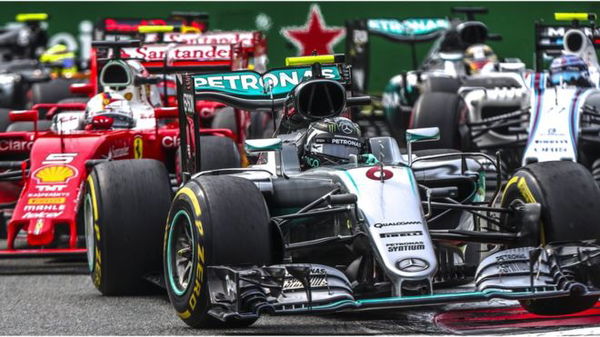

2017 was the year for major aerodynamic changes since the hybrid turbo era started in 2014. Something that many people expect to play to Red Bull Racing’s advantage. With those changes taking place, F1’s management had a major shakeup, with Liberty Media acquiring F1 from Bernie Ecclestone. The former CEO held the reins of the sport for F1 and is largely responsible for making it a popular sport, even though he has been under scrutiny for the last few years.
With Liberty vowing to bring in changes to make the sport better and the return of Ross Brawn to the sport, 2017 has had some very interesting changes.
Management Change
ADVERTISEMENT
Article continues below this ad
In the last week, F1 has undergone its biggest ownership change in nearly 40 years. US media group, Liberty Media have completed an $8 billion takeover of Formula One. With their promise to make F1 competitive and affordable, Bernie has been replaced by Chase Carey as the CEO of the group.

via Imago
F1 Supremo, Bernie has stepped down as the CEO of F1 and is now Chairman Emeritus.
Bernie who held the reins on the sport for nearly 40 years stays on as the Chairman Emeritus. How far involved he would be in Liberty’s plan for the future is yet to be seen.
As per the new management, 2 new people have been brought in important roles. It’s likely to see F1 expand into the USA market and the number of races to increase in the future.
First is the return of Ross Brawn. The former owner of Brawn GP and mastermind behind Schumacher’s run of success in F1 had taken a sabbatical after leading the Silver Arrows till 2013. Brawn is hired to head the technical aspects of the sport. He believes that the sport has become too complex and simplicity in rules and technical aspects is important for the future. He also wants to see more competitive racing (in the last few seasons, Mercedes have been well ahead of everyone). Another hiring made by Liberty is Sean Bratches, an executive who will look after the commercial aspects of F1. He has had experience in the growth of ESPN.

via Imago
Former Mercedes, Honda, Ferrari, Benetton boss, Ross Brawn has now returned to F1 with Liberty Media
Another interesting proposition of the Liberty Takeover is the inclusion of teams in management decisions. Liberty Media have set aside 19 million shares at a price of $21.26 to be kept for the teams to buy into the management. These would not grant the teams any voting rights on important matters, but they have an ownership stake in the sport they compete in. It is a model similar to the Major League Baseball in the USA.
According to new CEO Carey,
“We think it’s important to offer the teams the chance to invest in F1 and further align our interests.”
It is the dawn of a new era in F1.
Technical and Sporting rule changes
On the technical side of the sport, the manufacturers will no doubt be upgrading the performance of the engine, but most of the changes have been made on the aerodynamic aspects of the cars. The objective is to make the cars 4-5 seconds a lap quicker.

via Imago
Top side view of the changes in the cars.
The front wings of the cars are going to be extended from 1650mm to 1800mm. The wings will be swept in an arrow shape, to allow the cars to move closer to the one ahead without too much “dirty air” disturbing them. The rear wing has been moved back 200mm and its height is reduced by 150mm. With a bigger diffusor and barge boards being widened, this should give more down force to the car.

via Imago
Changes from the rear view of the cars
The tyres have changed. The front tyre width has increased from 245mm to 305mm. The rear tyre has been widened from 325mm to 405mm. This is to give extra grip for the quicker cornering speeds. This should allow drivers to also break deeper in slow speed corners and get on the accelerator faster. It has also caused some circuits to have their high speed corners reclassified as kinks on a straight. The width of the car has gone up from 1.8m to 2m. This means the weight of the cars have gone up by 22 kilos. To compensate, the cars will be allowed to race with 105 kilos of fuel, instead of 100.

via Imago
Changes from the front view of the car
The increased down force will make the car a much harder machine to drive and have a bigger strain on the drivers.
The Token system, which gave manufactures token to upgrade components of the power unit has been scrapped away. Instead, there are rules on the weight, dimensions and materials used on the various parts in the power unit. Also, drivers have just 4 power units a season (meaning each unit needs to last for at least 5 races) or else they will incur a penalty. The costs are expected to be down by around €1 million per unit.
On the race day, if it is a wet safety car start, the teams follow the Safety Car till it is deemed safe to start. Then the cars will line up on the grid for a regular start once the Safety Car pits. However, the laps which have been completed will still count to the race total.

via Imago
Wet race starts will revert to a normal start once the track conditions are declared raceable
In more interesting changes, drivers cannot stockpile on parts over their quota. In 2016, if a driver exceeded quota on the power unit components, they could take multiple grid penalties for a single race. As per new regulations, only 1 component’s component penalty is served in a race, with other components incurring further penalties.
Power Unit suppliers have an obligation to supply, mandating they supply units to a team even if they end up without an agreement. This was made in response to the 2015 breakdown in relationships between Red Bull, Torro Rosso and Renault, which left the two F1 teams in a bid to get last minute engine deals.
Driver Changes
Unsurprisingly, the driver’s grid has taken a shuffle. Only Ferrari, Red Bull Racing and Torro Rosso have retained the same driver line ups in 2017. It should be noted that due to ongoing administration of Manor, they are yet to confirm their driver line up for 2017.
Firstly, at McLaren, their double world champion line up has ended this year. Jenson Button is taking a sabbatical for 2017 (and a role of the reserve driver as well). By contract, McLaren have an option to bring him back in 2018. He is replaced by Stoffel Vandoorne, the 2015 GP2 Champion and McLaren reserve driver. It is not his race debut in F1, as he raced in place of Fernando Alonso at Bahrain 2016. During that weekend, he scored the first points for McLaren Honda in 2016. He will be partnering Alonso, as the 2 most successful team in F1 history looks to revive their fortunes.

via Imago
Vandoorne is replacing the 2009 World Champion, Jenson Button at McLaren Honda.
After a strong start to the season, Haas F1 endured a tough season. With 22 of their 29 points coming within the first 4 races of the season, and all from Romain Grosjean, the team dropped Esteban Gutiérrez. He failed to score a point for the team (with 11 being his best finish, and has not scored any points since 2013) and moved to Formula E. He has been replaced by Kevin Magnussen. The Dane, who was signed to Renault, turned down a 2017 contract with the French factory team and will join Grosjean this season.

via Imago
Magnussen joins Haas F1 after a difficult season with Renault.
To fill the seat vacated by Kevin Magnussen, Renault have signed Nico Hulkenberg from Force India. The German who spent most of his F1 career with Force India is one of the most consistent drivers on the grid. He has finally fulfilled his dream of moving to a Factory team.

via Imago
The Hulk leaves Force India for Renault F1
Force India have signed Esteban Ocon, who drove half a season for Manor in his debut season last year. The 2015 GP3 and 2014 European Formula 3 Champion had some very impressive runs towards the end of the season. He is also one of the 3 Junior Mercedes drivers.

via Imago
Force India have an exciting prospect in Ocon.
Initially, Williams’ Felipe Massa announced his retirement at the end of the season. He was replaced by Canadian and 2016 European Formula 3 driver, Lance Stroll. Stroll is the first Canadian to race in F1 since Jacques Villeneuve. However, Massa came out of retirement to sign for Williams for a year, to replace his teammate Valtteri Bottas, who left the team.

via Imago
Lance Stroll is now partnering Felipe Massa, the man he was initially to replace.
Mercedes were initially set to retain their driver line up since 2013. However, a few days after winning his maiden World Championship, Nico Rosberg announced his retirement. With every driver being linked to the vacant seat, it boiled down to a choice between Valtteri Bottas and Pascal Wehrlein. In the end, the more experienced Finn got the nod, and Bottas signed for Mercedes, partnering Lewis Hamilton.
ADVERTISEMENT
Article continues below this ad

via Imago
#77 now partners #44 at Mercedes.
Sauber released Felipe Nasr (who woefully underperformed) and replaced him by Manor’s Pascal Wehrlein. The German who is a part of Mercedes’s junior program and the reserve driver for the constructors, was linked to the vacated seat of Nico Rosberg.
ADVERTISEMENT
Article continues below this ad

via Imago
Pascal Wehrlein is now a Sauber driver.
ADVERTISEMENT
ADVERTISEMENT
ADVERTISEMENT
ADVERTISEMENT

